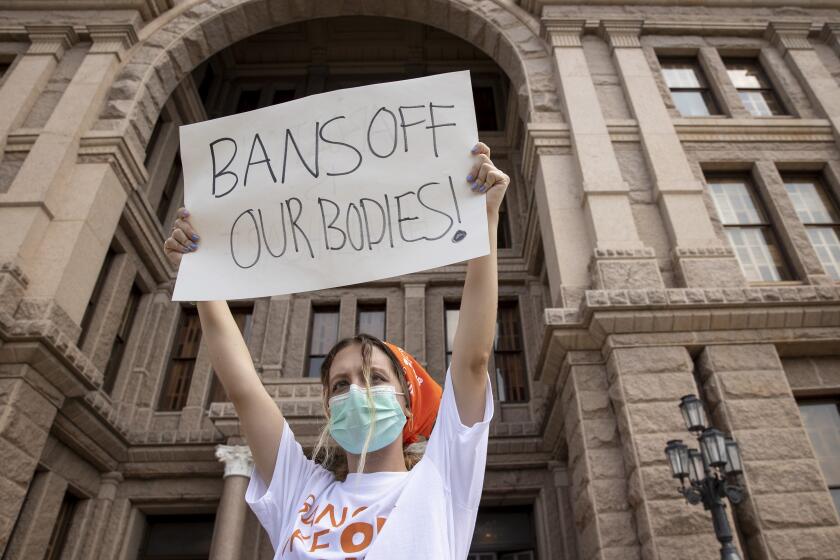The Texas abortion ban is already harming reproductive rights beyond Texas

- Share via
On Monday, the Supreme Court will hear arguments on the Texas abortion ban that it has so far declined to block.
In the two months since SB 8 was passed, access to abortion in Texas has been severely restricted, and its effects have gone well beyond Texas.
My organization, the Women’s Reproductive Rights Assistance Project, based in Los Angeles, has heard from a surge of patients traveling out of Texas for care. We work with a network of more than 700 clinics and doctors to help pay for abortions and emergency contraception in all 50 states.
Getting an abortion can be difficult for Californians who cannot afford one or live far from a clinic that provides the procedure.
The volume of requests for assistance we receive has doubled in the last year, including since the Texas ban. Recently, one of our volunteers got a call from an Illinois clinic about a Texas teenager who had traveled to three other clinics outside her state looking for an appointment. Her abortion procedure would cost close to $4,000, which she couldn’t afford on her own.
WRRAP secured the funding this person needed with help from other organizations. But we hear desperate stories like hers daily — especially since the recent increase in antiabortion legislation. Nineteen states have enacted 106 abortion restrictions, including 12 bans, this year alone.
People seeking reproductive care in those states face a mountain of stress. Each day they are denied abortion care, the cost goes up. Not everyone can afford to leave their state due to financial and other reasons. Low-income women have little or no financial resources, and often no support from the partner involved in the pregnancy. In so many cases, they recognize that they can’t afford to raise a child but are also unable to pay the full cost of abortion or emergency contraception.
Those who can’t find the funding end up having to go through an unwanted pregnancy. The others — increasingly, those traveling from Texas to states that are relatively close or cheap to get to including California, Oklahoma, New Mexico and Illinois — come to groups like ours. That means greater demand for the procedure in the Western states absorbing the impact of the Texas law, and greater costs for patients the longer they have to wait.
Though Texas’ situation is by far the most alarming, lawmakers in other states including Florida and Oklahoma have expressed intent to follow their model. Last week, Oklahoma, where a number of Texas patients are going, had three extreme abortion restrictions temporarily blocked by a judge. Failure of the courts to act quickly in lifting bans will continue to put many individuals in danger.
Editorial: The Supreme Court has to save more than abortion access in Texas. It has to save itself
The Supreme Court must recognize that the Texas abortion restriction is unconstitutional and reaffirm its own legitimacy.
Californians are fortunate that our state has enshrined in statute protections for abortion as a fundamental right. Should the Supreme Court overturn Roe vs. Wade in deciding a Mississippi case challenging that precedent, and if more states copy Texas’ extreme legislation, only California and six other states — Connecticut, Hawaii, New York, Oregon, Vermont and Washington — will guarantee the right to abortion by state constitutional provision or laws.
If abortion rights become even more restricted in most states, more women will need financial support to get abortion care in states that allow it. Yet the National Committee for Responsive Philanthropy reported that between 2015 and 2019, less than 3% of funding for reproductive rights issues from foundations went to assistance programs that help people get abortions.
This lack of funding most affects Americans who already contend with other obstacles to healthcare. In 2020, WRRAP funded 2,250 people across the country at a total cost of $455,000. Of those, 77% were people of color, 55% were unemployed and 5% were under age 18. We expect to increase our assistance by 32% this year to meet growing demand.
Even with help from organizations like mine, thousands of patients still find it impossible to obtain reproductive healthcare without a struggle, including dealing with the burden of traveling long distances to find a clinic or worries about taking time away from work and family. Some won’t seek services over concerns such as their immigration status.
We all need to do more than watch state legislatures take away abortion rights, hoping the Supreme Court will maintain constitutional principles that have stood for five decades. We need businesses to support reproductive care and provide health insurance to cover abortions for their employees. We need to vote for candidates who will support reproductive rights at the local, state and federal levels. And we need to destigmatize abortions by continuing to talk about them as what they are: safe medical procedures that nearly 1 in 4 U.S. women will have by the age of 45.
With legal uncertainty looming and as lawmakers in some states continue to ban abortion, California and others will have to pick up the slack.
Sylvia Ghazarian is executive director of the Women’s Reproductive Rights Assistance Project.
More to Read
A cure for the common opinion
Get thought-provoking perspectives with our weekly newsletter.
You may occasionally receive promotional content from the Los Angeles Times.








